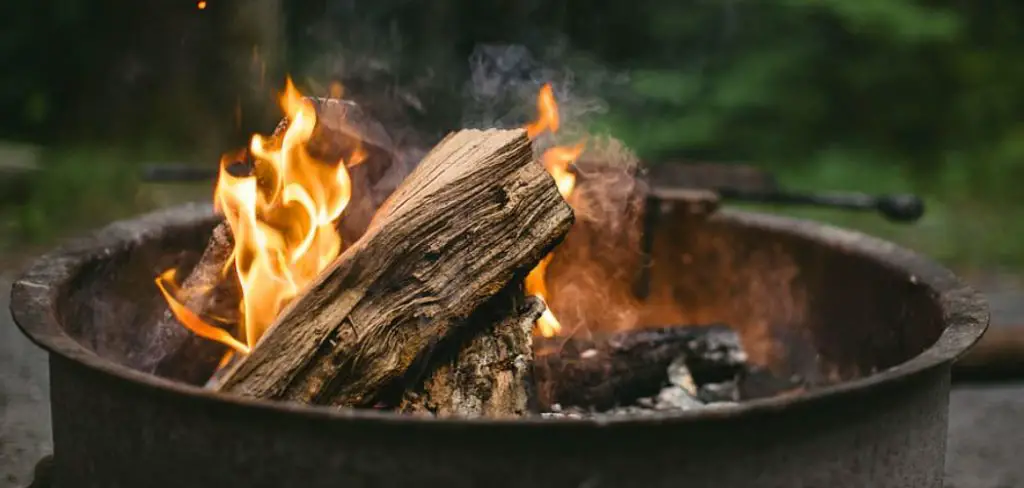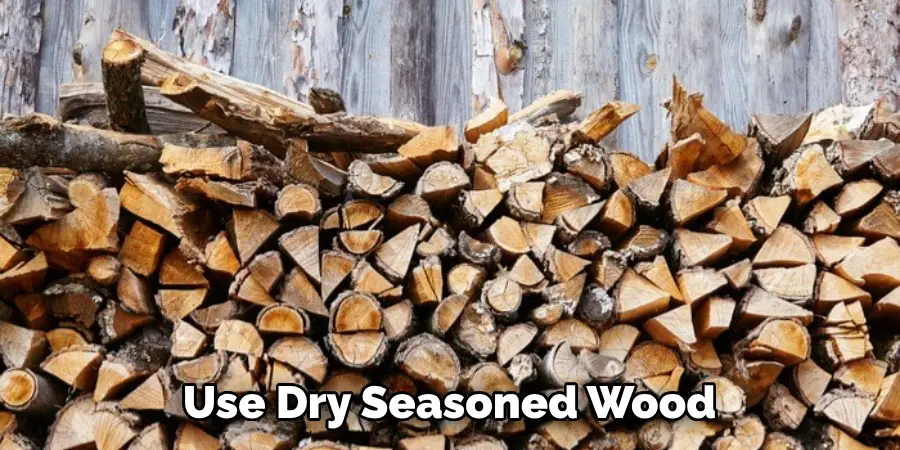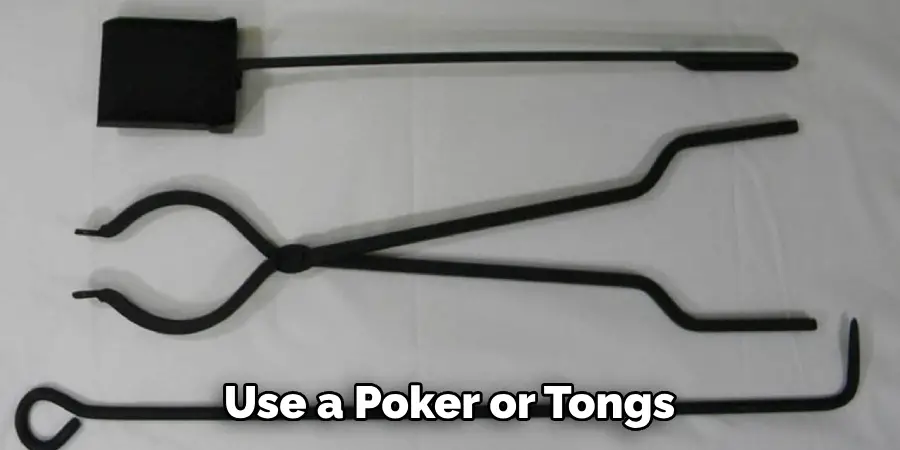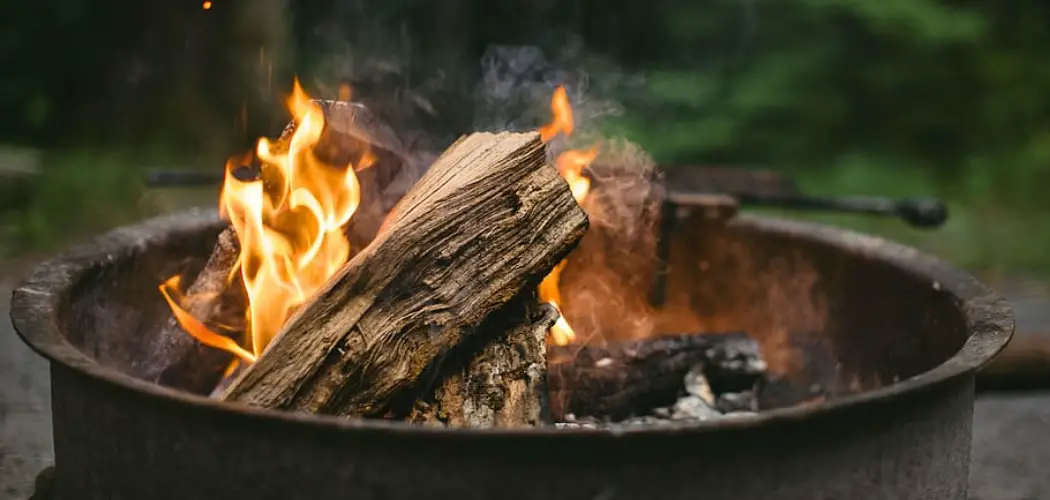Nothing beats the warmth and cozy atmosphere of a fire pit. Whether you’re enjoying a fun night with family and friends or just relaxing alone, a fire pit can be the perfect addition to your outdoor space. But lighting a fire pit can be a bit tricky, especially if you’re using wood. In this blog post, we’ll go over some tips and tricks on how to light a fire pit with wood and make your outdoor experience even more enjoyable.

Can You Light a Fire Pit with Wood?
Gathering around a fire pit on a crisp evening is the perfect way to spend time with family and friends. But before getting too comfortable, the question arises: can you light a fire pit with wood? The answer is yes! Using wood as fuel for a fire pit is not only common, but it can also enhance the ambiance of your evening.
However, it’s important to take proper safety precautions and check local regulations before lighting a fire. With the right tools and preparation, you’ll be roasting marshmallows and enjoying the warmth of a wood fire in no time.
Why Should You Light a Fire Pit with Wood?
There’s nothing quite like cozying up around a warm, crackling fire on a chilly evening. And while there are many ways to light a fire pit, nothing quite beats the classic method of using wood. There’s something about the natural beauty of the flames dancing around the logs that just can’t be replicated with other fuels.
The smell of the burning wood is also something to be cherished – it’s warm, earthy, and downright comforting. Plus, using wood to light your fire pit is a more sustainable and eco-friendly option than other fuels. So next time you’re looking to set the scene for a relaxing evening outdoors, consider lighting your fire pit with wood for an experience that’s as authentic as it is enjoyable.
How to Light a Fire Pit with Wood – Tips and Tricks
1. Choose the Right Wood
The first step in lighting a fire pit with wood is choosing the right wood. It’s important to use dry, seasoned wood because it burns more efficiently and produces less smoke. Hardwoods like oak, maple, and birch are good options for firewood because they burn longer and produce less creosote than softwoods like pine and cedar. You should also avoid using treated or painted wood, as they can release harmful chemicals when burned.

2. Start with a Clean Fire Pit
Before lighting your fire pit, make sure it’s clean and free of any debris. Remove any ashes or leftover wood from previous fires, and use a brush or broom to sweep away any leaves, twigs, or other debris that could start a fire elsewhere. You should also clean out any excess debris from the bottom of the fire pit, as this can help improve airflow and make it easier to light your fire.
3. Build Your Fire Properly
To build an optimal fire, you should use the “teepee” method. Start by arranging small kindling in a teepee shape in the center of your fire pit, leaving an opening on one side to allow for airflow. Place a few larger pieces of firewood around the kindling, again leaving an opening for airflow.
Light the kindling from the bottom using a lighter or match, and carefully add more kindling and firewood as the fire grows. You can use a firestarter or newspaper to get your kindling started. Avoid using gasoline, lighter fluid, or any other flammable liquids.
4. Control the Fire
Once your fire is burning, it’s important to control it. Keep a close eye on it, and never leave it unattended. You should also avoid adding too much wood at once, which can smother the fire and produce more smoke. Instead, add smaller pieces of wood as needed to keep the fire going. Use a poker or tongs to move logs around and adjust their position to maintain an even fire.
5. Extinguish the Fire Safely

When you’re ready to put out your fire, do so safely. Use a shovel and bucket or hose to extinguish the flames, and ensure the fire is completely out before leaving it unattended. You should also wait until the ashes are cool to dispose of them, and never put them in a plastic container or dumpster. Instead, use a metal container or bury them in your garden.
6. Clean the Fire Pit
Once your fire is out, clean the fire pit. Use a brush or broom to remove any ashes, and use a wet rag to wipe away any soot from the walls of the fire pit. If you have accumulated a lot of ash, it’s best to dispose of it in an outdoor metal container or bury it in your garden. Never put it in a plastic container or dumpster; this can start a fire.
7. Store Your Firewood Properly
The last step is to store your firewood properly so it’s ready for use the next time you light your fire pit. Keep the wood dry and covered, preferably in an outdoor shed or under a tarp. This will help keep moisture out and prevent it from rotting or becoming infested with pests. Ensure you only use seasoned firewood that has been dried for at least six months, as this is the best type of wood for burning in a fire pit.
Following these simple tips can help ensure your next fire pit experience is safe, enjoyable, and smoke-free. So grab some firewood, follow these guidelines, and get ready to light a cozy fire!
5 Considerations Things When You Need to Light a Fire Pit with Wood

1. Type of Wood
The type of wood you use to light a fire pit is important. Hardwoods, such as oak and hickory, are the best choice for fire pits because they burn slowly and produce more heat than softwoods like pine or cedar. It’s also important to make sure the wood is dry, as wet wood will not burn properly.
2. Kindling
Kindling is small pieces of wood that are used to start a fire in a fire pit. The best kindling materials are small twigs and dry leaves, but you can also use newspaper or cardboard if necessary. When using kindling, make sure to place it in the center of the pit so that it catches easily when lit.
3. Firestarter
A fire starter is an item such as a match or lighter that is used to ignite the kindling in a fire pit. It’s important to make sure your fire starter is reliable and easy to use, so test it out before you attempt to light your fire pit with it.
4. Ventilation
Ventilation is key when lighting a fire pit with wood because it allows oxygen to reach the burning wood and helps keep the flames going strong. Make sure there is adequate ventilation around your fire pit by keeping windows open or using fans or blowers if necessary.
5. Safety Precautions
It’s always important to take safety precautions when lighting a fire pit with wood, such as keeping flammable objects away from the flames and wearing protective clothing and eyewear while tending the flames. Additionally, never leave a burning fire unattended and be sure to extinguish all embers completely before leaving the area.
By following these five considerations when lighting a fire pit with wood, you can ensure your experience is both safe and enjoyable. With the right preparation and safety measures in place, you will be able to enjoy a cozy fire without any worry or hassle. Have fun!

Benefits of Light a Fire Pit with Wood
There’s something magical about gathering with friends and family around a crackling fire. While there are many ways to light a fire pit, there are certain benefits that come with using wood. For one, it’s a cost-effective option. Unlike propane or natural gas, wood is readily available and relatively inexpensive. Additionally, wood fires provide a unique ambiance and warmth that can’t be replicated.
The smell of burning wood and the dancing flames create an inviting atmosphere that draws people in and fosters deep conversations and connections. Lighting a fire pit with wood is also better for the environment, as wood is a renewable resource. So next time you’re planning an outdoor gathering, consider lighting a fire pit with wood and experience all the benefits it has to offer.
Some Common Mistakes People Make When Trying to Light a Fire Pit with Wood
Sitting around a fire pit with friends or family can be the highlight of any outdoor gathering, but things can quickly turn frustrating if you can’t seem to get the fire started. Unfortunately, there are a number of common mistakes that people make when trying to light their fire pit with wood. For starters, failing to properly prep your fire pit can make it much harder to get the fire going.
Similarly, not choosing the right type of wood or using wood that is too wet can also hamper your efforts. Lastly, trying to rush the process by dousing your wood in gasoline or other accelerants can not only be dangerous, but it can also make it harder to start your fire. To ensure a successful fire pit experience, it’s important to avoid these common mistakes and have patience while you work to get your fire going.
Conclusion
A fire pit can be a great addition to your outdoor lifestyle, but lighting it with wood can be tricky. By choosing the right wood, starting with a clean pit, building your fire properly, controlling the fire, and extinguishing it safely, you can enjoy a safe and cozy fire all season long. So why not get outside, gather some wood, and light up your fire pit today? Thanks for reading our post about how to light a fire pit with wood.


